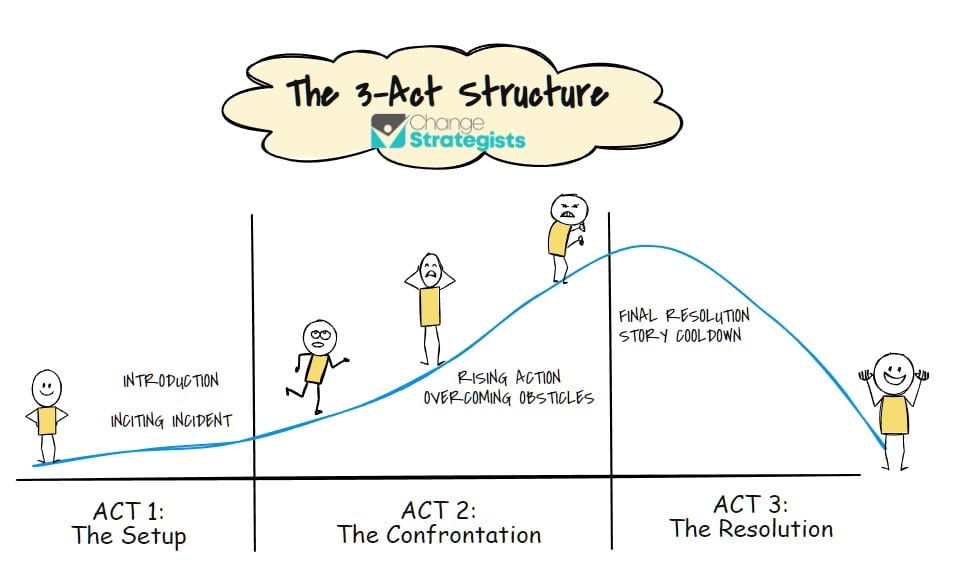When giving a presentation, it’s important to engage your audience and hold their attention. Just like in storytelling, this can be done by using a number of techniques, such as dialogue, setting and characters.
How is giving a successful presentation similar to storytelling?
Giving a successful presentation is similar to storytelling as both storytelling and presentations involve the use of narrative techniques to engage an audience and move them towards a certain goal. They require the speaker to build suspense, create conflict, and entertain their listeners. And, importantly, both rely on effective communication skills in order to ensure that the message is understood and appreciated by those who hear it.
A good storyteller uses their voice, gestures, and facial expressions to tell a story in such a way that the audience feels like they are part of the experience. When presenting, you should use these same techniques to engage with your audience.
Your presentation should also have a clear goal or message that you want to communicate to your audience. This can be accomplished by focusing on the story you want to tell rather than simply reciting data or facts. In order to create an engaging narrative, it’s important to find the human element in your story and make sure that it is relevant to your listeners.
Finally, always remember that practice makes perfect! The more prepared you are for your presentation, the more confident you’ll feel when delivering it.
What are some ways to make your presentation more engaging?
There are many ways to make your presentation more engaging for your audience, but some of the most common include:
- Using visual aids and graphics to help explain your points.
- Making use of humor to keep your audience engaged.
- Creating a dynamic and interactive environment by asking questions during your presentation.
If you struggle to make beautiful presentations check out this special off on Graphue Presentation Templates: https://appsumo.8odi.net/GjB1jn
The above points are fairly common sense; one of the most effective and overlooked techniques is storytelling.
Stories are remembered more than facts alone, so by weaving a narrative into your decks you ensure that you don’t waste time and effort, and that your audience remembers what you present.
Good storytelling can offer a more engaging way to present; this is where training in how to give presentations can be helpful.
How can storytelling make your presentation more engaging?
When you’re giving a presentation, it’s important to engage your audience as much as possible. Fact-heavy presentations stacked with graphs and statistics won’t keep your audience curious, and in fact may result in them losing interest thinking it is a boring presentation.
One way to create engagement is through storytelling. Stories are remembered more than facts alone, so using them in your presentations can be really helpful in getting your message across.
In addition, storytelling is a great tool for creating narratives. Narratives help people understand and remember information better, so using them in your presentations can make them more engaging for your audience.
This excellent TEDx talk is an insightful look into the science of storytelling and a great example of the use of storytelling in a presentation.
What are some tips for using storytelling in your presentation?
When it comes to making a presentation more engaging, storytelling is one of the most powerful tools you have at your disposal. By using stories that are relevant to your topic, you can capture your audience’s attention and hold it throughout the entire presentation.
Here are some tips for using storytelling in your next presentation:
1) Know what your audience’s viewpoints are and don’t be afraid to mention them in a presentation. This will help you frame your topic in a way that is interesting to them and makes them more receptive to what you have to say.
2) Frame your topic by starting from where the audience is already familiar with, or even better where they will want it to go next. This will help keep their attention focused on you and ensure that they stay interested in what you’re saying.
3) Make sure that you frame the topic in a way that is interesting to your audience. Don’t just tell them about things they already know – give them information they can use and make sure it relates back to your call for action.
4) Think about the feelings you want from your audience, such as making them remember important facts with an engaging story. Make sure the story you choose is relevant to your goal and helps achieve it.
5) Remember that the audience is the hero of your story. Make sure they feel like they are a part of it and that they can relate to the characters you choose to use.
6) Use relevant images, videos, props etc as supplements to your story. This will help engage your audience more fully and make them feel like they are a part of what’s happening on stage.
7) A story is one of the best ways to engage an audience. Make sure that there is a conflict, contrast or action in your presentation; this will ensure audience engagement.
8) Use the 3-act structure and build to a climax. This will keep your audience engaged and make sure they remember what you said when you’re done speaking.
9) Create suspense by having the audience think they know where your story is going, but then surprise them with an unexpected turn of events. This will keep them guessing and ensure that they stay interested in what you have to say.
10) Consider telling personal stories that show human nature and what motivates you as speaker in your presentation – people love hearing real-life stories!
What is the 3-Act Structure?
I mentioned the 3-act structure above, and if you’re not a storyteller you might wonder what this is.
The three-act structure is a model of storytelling that describes how stories unfold over time. The three acts are introduction, conflict, and resolution. This model helps storytellers understand their audience and what they want to hear.
This is a model that is used in everything from Movies, TV shows, commercials, YouTube videos and now presentations.
The structure helps you tell a story that will help your audience understand your message. A good story should have a beginning, middle, and end. You should also tell a story that is relevant to your audience.

In business presentations, this structure can be used to engage your audience, communicate your message more effectively, and ultimately achieve your desired outcome.
Here’s how it works:
The first act (the setup) sets the scene and introduces the characters. A character could be you, the audience, or a customer. This section establishes the conflict or challenge that must be addressed in Act II.
The second act (the confrontation) is where most of the action takes place. This is where you present solutions to address the challenges introduced in Act I and illustrate their consequences.
The third act (the resolution) brings closure to the story by wrapping up loose ends and delivering a satisfying conclusion.
Now remember this isn’t the next blockbuster film, this story template works for very short, 60 second stories. This excellent video explains the structure in the context of short form stories.
How can you use storytelling to connect with your audience?
Storytelling is a powerful way to connect with your audience. It can be used to illustrate a point, as an accompaniment to demonstrations, or even as a stand-alone presentation. When you’re telling a story, it’s important to make sure that it is relatable and interesting.
One of the best ways to connect with your audience is by using the hero’s journey. This storytelling device has been used in books and movies for many years and is recognizable to most people. The hero’s journey follows a pattern that can be found in almost every narrative. The protagonist overcomes their reluctance to change and enters an adventure in a special world. They then return home changed by their experience.
The hero’s journey can be used in presentations and advertisements to engage viewers. One great example is the Budweiser Lost Dog commercial.
In the ad, the story tells of how a little puppy gets separated from his family and literally has a heroes journey, trying to get back home. This is also a great example of the 3 act structure used in a short form story. Watch the video and see if you can spot the 3 acts in use.
When you’re building your presentation, it’s important to position your audience as the hero. This will make them feel more engaged and invested in your message.
In her Ted Talk, pro snowboarder Amy Purdy talks about losing both of her legs to bacterial meningitis and re-learning how to snowboard eventually winning gold medal. She tells her inspiring story in a way that makes the audience feel like they are right there with her.
When you’re telling a story, it’s important to make sure that it is interesting and relatable. One great way to connect with your audience is by using the hero’s journey. The hero’s journey follows a pattern that can be found in almost every narrative. The protagonist overcomes their reluctance to change and enters an adventure in a special world. They then return home changed by their experience.
What are some ways to make your presentation more memorable?
When you weave a narrative into your presentation, it encourages an audience to remember your message more effectively with better retention. In addition, personal stories are more memorable than those that do not include them.
A compelling story can make any presentation much more memorable. It helps engage the audience and makes it easier for them to recall the information later on. If you want to make your presentations more engaging and interesting, then consider using stories as a tool to achieve this goal.
Other key strategies include using visuals, making sure you have a clear message, and being prepared to answer questions. Additionally, it’s important to keep in mind the context of the audience you’re speaking to – think about what they know and don’t know, and tailor your presentation accordingly.
What are some common mistakes people make when using storytelling in presentations?
When it comes to storytelling in presentations, many people make the same mistakes. Here are four of the most common ones:
- Not having a clear point or goal for your story. When you’re telling a story, always keep in mind what you want your audience to takeaway from it. What do you want them to do as a result?
- Choosing the wrong story to illustrate your point. Make sure that the story you choose is relevant and applicable to your topic.
- Failing to engage your audience with your story. Make sure that you’re actively involving your listeners by using dynamic storytelling techniques.
- Making up stories instead of using true stories from personal experience or research. Always use real-life examples whenever possible–people are more likely to trust and believe information when it’s presented in a relatable way.
One of the most common mistakes is failing to build a strong foundation for your story. Without a strong sense of context, your audience will struggle to connect with your words. Additionally, many speakers tend to rely too much on visual aides (such as Powerpoint slides) instead of telling their stories directly. By relying heavily on visuals, speakers often lose the opportunity to build rapport with their audience and leave them feeling frustrated and bored.
Happily ever after…
In conclusion, if you’re struggling with your presentations, ask yourself “How is giving a successful presentation similar to storytelling?” and remember that the techniques of storytelling, such as the 3 act structure, are powerful tools that can be used to make business presentations more engaging and memorable.
By understanding what happens in each act and how to use this structure effectively, you can create presentations that will capture your audience’s attention and get your message across clearly.





